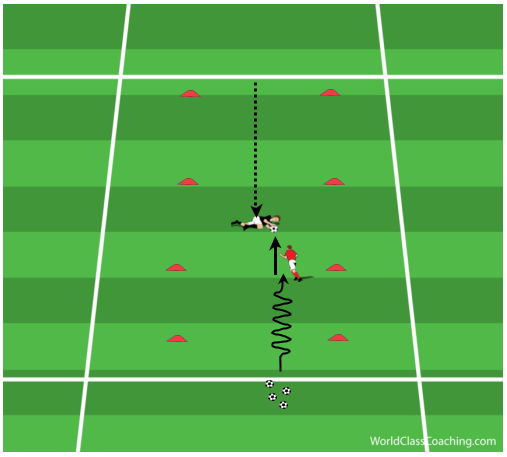By Tony Englund -
When I give goalkeeper training sessions to coaches, many ask about teaching their goalkeepers to deal with break-aways. In the first of a two-part article on the subject, we’ll look at building the goalkeeper’s confidence in blocking and closing down. In the second portion, tips for dealing with the break-away situation in match-like situations will be shared.
It is useful to invert the break-way situation as a teaching model, looking at the final, blocking save as a start point. Young goalkeepers in particular often hesitant to get into the feet of the attacker, though this gives them the best chance to make a save.
Blocking line
The goalkeeper starts from his feet and works to his left (above), covering each successive ball in the line. In the warm-up phase, the coach steps to each ball and taps at it as the goalkeeper covers, giving light pressure. At this stage, we’re most concerned with the proper technique for covering (landing points – outside of knee, hip, shoulder), stretching the body out behind the ball, holding the ball with proper hand position (bottom hand on back, top hand on top of ball), holding the ball in line with but well in front of the eyes (elbows not locked) and using the top leg to propel and protect oneself. After the exercise is completed in the direction shown, repeat the other way, with the goalkeeper working on his right side.
Progression
- Now the coach arrives at the ball just before the goalkeeper and the goalkeeper must block the shot or push by the coach. Concentrate on getting down quickly and close to the ball to maximize the ability to close down. Note the dive angle of the ‘keeper should be slightly forward, not backward (in which case one’s arrival is late and less goal is covered). The coach should allow progressively less time between kicks, forcing the goalkeeper to move at speed through the line). Again, work in both directions.
- When the goalkeeper appears comfortable, try to force rebounds and play those rebounds (can the goalkeeper cover or tighten up on the ball and block again?)
Close and cover in a grid
The next step is to add movement. To build the goalkeeper’s confidence, work in a grid that is 5 yards wide and 12 yards long. The attacker dribbles toward the goalkeeper, taking a longer touch with his second or third touch and the goalkeeper covers. The goalkeeper’s movement to close down is characterized by a couple longer steps to close the ground and then shorter steps (in case an adjustment is needed) before covering. In this way, the goalkeeper becomes accustomed to reading touches and being aggressive in this situation.
Progression
- Allow the attacker to try to beat the goalkeeper on the dribble (no shooting). This creates a more realistic exercise where the goalkeeper can learn to close down under pressure.
- After his first touch, the attacker must fake a shot and then continue to dribble (no shooting). In this environment, the goalkeeper must take a ‘set –step’ when he sees that the attacker might shoot. This step is important because talented attackers will try to catch the goalkeeper moving at them and slide the ball by before the goalkeeper can get set. Here, the goalkeeper stops and sets and then continues to close down when the attacker dribbles again.
- Open play. The attacker can shoot or dribble. Note that the attacker must play at speed for this to be effective training for the goalkeeper. This is a very good setting for the goalkeeper because the smaller goal helps them become confident in coping with a single attacker in a break-away situation.
By Tony Englund - Holds an NSCAA Premier License and 11 other diplomas. Tony has presented goalkeeping clinics for the NSCAA and is the author of six books including: Goalie Wars! and Art of the Duel




